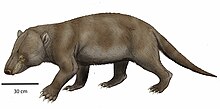| Trogosus Temporal range:
| |
|---|---|

| |
| Trogosus hyracoides skull at the National Museum of Natural History | |
|
Scientific classification
| |
| Domain: | Eukaryota |
| Kingdom: | Animalia |
| Phylum: | Chordata |
| Class: | Mammalia |
| Order: | † Tillodontia |
| Family: | † Esthonychidae |
| Subfamily: | † Trogosinae |
| Genus: | †
Trogosus Leidy 1871 |
| Species [1] | |
| |
Trogosus is an extinct genus of tillodont mammal. Fossils have been found in Wyoming, California, [2] and British Columbia, [3] and date from the Eocene between 54.8 and 33.7 million years ago.

Trogosus was a
bear-like herbivore with a large, short
skull and flat feet, and had a skull 35 cm (14 in) long with an estimated body weight of 150 kg (330 lb).
[4] It had large,
rodent-like
incisors, which continued growing throughout the creature's life. Judging from the heavily worn
molar teeth, Trogosus fed on rough plant material, such as roots and tubers.
[5]
Notes
- ^ Trogosus in the Paleobiology Database. Retrieved July 2013.
- ^ Miyata, Kazunori; Deméré, Thomas A. (17 February 2016). "New material of a 'short-faced' Trogosus (Mammalia, Tillodontia) from the Delmar Formation (Bridgerian), San Diego County, California, U.S.A." Journal of Vertebrate Paleontology. 36 (3): e1089878. doi: 10.1080/02724634.2016.1089878. S2CID 130776132. Retrieved 11 April 2022.
- ^ Russell 1935
- ^ Kemp 2005, p. 240
- ^ Palmer 1999, p. 236
References
- Kemp, Tom S. (2005). The Origin and Evolution of Mammals. Oxford University Press. ISBN 0198507615. OCLC 56652579.
- Leidy, J. (1871). "Remains of extinct mammals from Wyoming". Proceedings of the Academy of Natural Sciences. 23: 113–116. Retrieved July 24, 2013.
- Palmer, D., ed. (1999). The Marshall Illustrated Encyclopedia of Dinosaurs and Prehistoric Animals. London: Marshall Editions. ISBN 1-84028-152-9.
- Russell, Loris Shano (1935). "A middle Eocene mammal from British Columbia". American Journal of Science. 5. 29 (169): 54–55. doi: 10.2475/ajs.s5-29.169.54.


